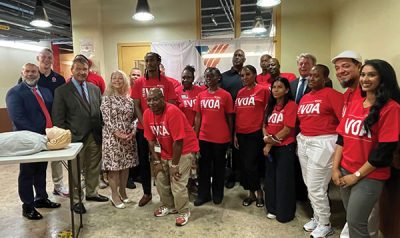Narcan Kits at County Shelters to Help Most Vulnerable People
News Based on facts, either observed and verified directly by the reporter, or reported and verified from knowledgeable sources.

Westchester County has installed metal boxes that contain two doses of the lifesaving medication Naloxone at its three shelters in an attempt to prevent opioid overdoses for a vulnerable population.
Four county departments – health, public safety, social services and community mental health – are partnering on the initiative, which helps to address multiple issues that many people face who are addicted to opioids.
The “Naloxbox program” provides a wall-mounted unit in an easily accessible place in each shelter so almost anyone can provide a person with the medication if they are experiencing an overdose.
“By placing it in this facility and other similar facilities, it puts the lifesaving medicine immediately at the fingertips to save a life, to save a person’s life and from dying of an overdose of opioids,” County Executive George Latimer said.
Last Wednesday, Health Commissioner Dr. Sherlita Amler joined Latimer and other county officials and representatives from the Volunteers of America shelter on Operations Drive in Valhalla to announce the program. Amler also provided a demonstration on a mannequin on how to administer the medication.
The commissioner said Naloxone, or also known by its brand name of Narcan, is easy to give and is safe to use in the event a person may be experiencing a health episode but it is unclear whether it’s an opioid overdose.
Amler said if someone has overdosed on opioids, providing the drug by spraying two puffs into the nostrils can almost magically prevent a death.
“It really does need to be a drug that’s within reach because when someone is overdosing, you literally have seconds, only a matter of one or two minutes, to get their brain back functioning, to get them breathing again before the effects become, unfortunately, non-reversible and the person is dead,” Amler said.
If a person is in danger because of opioids, they will respond within moments and may not even know what happened, Amler mentioned.
She reminded the public that even if someone is brought back by using Naloxone, emergency responders must still be called because the medication will wear off in 30 to 90 minutes and medical attention will be needed.
The urgency to place the Naloxboxes in shelters cannot be stressed strongly enough, said Lijin Thomas, sector director for the Volunteers of America of Greater New York, which operates the Valhalla shelter. Thomas said it is easy to draw conclusions and stigmatize those who are there, but many are suffering from mental health issues or substance abuse, made worse because of the pandemic.
It is also appropriate that the Naloxbox in the Operation Drive shelter is near the first aid box and defibrillator, she said.
“As a shelter provider, we assess the clients and connect them to the appropriate services,” Thomas said. “Even during the pandemic, we saw an increase of clients becoming more symptomatic, their anxieties increasing and the clients resorting to using more negative coping mechanisms.”
The Opioid Rescue Kit includes tearaway instruction sheets that include graphics on Narcan use as well as a mask to perform rescue breathing, if necessary. The Health Department also created signage with a QR code that links to a 50-second video clip on how to administer Narcan that is posted near each Naloxbox.
In 2020, about three-quarters of the nearly 92,000 drug overdoses that occurred in the United States involved an opioid.

Martin has more than 30 years experience covering local news in Westchester and Putnam counties, including a frequent focus on zoning and planning issues. He has been editor-in-chief of The Examiner since its inception in 2007. Read more from Martin’s editor-author bio here. Read Martin’s archived work here: https://www.theexaminernews.com/author/martin-wilbur2007/
